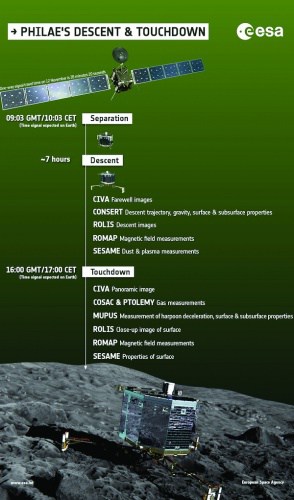The big engineering story of the week takes place approximately 300 million miles away from Earth this Wednesday.
At 0835 on November 12, the European Space Agency’s Rosetta Mission will release its high-tech passenger, the Philae lander, in an attempt to land on comet 67P/Churyumov-Gerasimenko.
On release from Rosetta, the lander will be around 22.5km from the centre of the 2.5-mile wide comet and touchdown is scheduled approximately seven hours from launch.

Full details of its development and use can be found here but to recap briefly, Ptolemy is packed with equipment that will allow it to analyse the comet’s composition, particularly the isotopes which make up the sample.The Philae lander contains significant pieces of UK-built kit in the form of the Ptolemy instrument, which will hopefully deploy successfully and assuage those who direct great hoots of derision at exploration beyond the Earth’s atmosphere; and the harpoon system which the lander will use to haul itself down to the comet’s surface, which can be seen in action in this video story.
The first sequence of surface science experiments will begin about an hour after touchdown and will last for 64 hours. By doing so, Philae and Ptolemy are expected to help further our understanding of how the solar system was formed and shed further understanding onto the origins of life itself.
Rosetta will remain in orbit around the comet through 2015. The orbiter will continue detailed studies of the comet as it approaches the sun and then moves away. NASA has three of the 16 instruments aboard the orbiter and NASA Television says it is going to show live coverage of the attempt.
Back on terra firma and a nod to Advanced Engineering UK taking place on Tuesday and Wednesday this week at the NEC in Birmingham.
Advanced Engineering UK encompasses five high growth areas – aero, composites, automotive, auto electronics, and performance metals – into what the organisers describe as ‘a hugely exciting integrated UK and international technology transfer and business development environment’.
A packed seminar programme contains two strands with relevance to an event taking place this week centred on skills. In Birmingham tomorrow two afternoon sessions will look at developing a skills strategy for the future, which is hosted by CompositesUK; and Addressing the Skills Gaps in Composites Manufacture, to be delivered by Brian Thornton, skills specialist and training consultant at the National Composites Centre.
These discussions coincide with the launch of the Your Life campaign, with the education secretary Nicky Morgan delivering the keynote.
Your Life - supported by BAE Systems, Carillion, Ford Motor Company, Rio Tinto, Shell, and Nestle – is a three-year campaign aimed at equipping young people with the maths and science skills they’ll need to succeed in a global economy.
The campaign aims to increase the number of students studying maths and physics by 50 per cent and increase the opportunities for all people, particularly women, to pursue careers that require STEM skills.
In a similar vein, the QEPrize Ambassador Network launched last week in London.
This international network of young engineers will act as ambassadors for the QEPrize (Queen Elizabeth Prize for Engineering), and the engineering profession, and in doing so it is hoped they will help to encourage the next generation of engineers.
Anyone interested in becoming a QEPrize Ambassador must be graduate employees or apprentices with less than 20 years’ experience in their engineering career, who are keen to inspire and engage others in engineering. More details can be found here.
Young people considering their options at school might like to hear that engineering has been classified as one of the 40 per cent of professions considered in research findings to be ‘low or no risk’.
This is the conclusion of a study carried out by Deloitte with Carl Benedikt Frey of the Oxford Martin School, and Michael A Osborne, from Oxford University’s Department of Engineering Science.
Their London-centric research looked at the likely effect of advances in technology and automation on the UK jobs market.
They say: ‘Technology, automation and robotics will cause a significant shift in the UK labour market in the next twenty years, with 35 per cent of existing jobs at risk of being replaced.
‘Thirty-five per cent of existing jobs in the UK, decreasing to 30 per cent in London, are at high risk from automation over the next two decades. “High risk” jobs are in office and administrative support; sales and services; transportation; construction and extraction; and production.
‘However, 40 per cent of UK jobs are at low or no risk. In London, 51 per cent of jobs are at low or no risk. “Low or no risk” jobs are in skilled management; financial services; computing, engineering and science; education; legal services; community services; the arts and media; and healthcare.’
Key findings from the research include:
- 35 per cent of existing UK jobs at high risk of replacement in next twenty years, 30 per cent in London
- 40 per cent of UK jobs are low or no risk, 51 per cent in London
- Lower-paid jobs over five times more likely to be replaced than higher-paid, almost eight times as likely in London
- 73 per cent of businesses in London plan to increase headcount overall, with advances in technology requiring new skills and a major shift in job types
Source: Deloitte











UK Enters ‘Golden Age of Nuclear’
The delay (nearly 8 years) in getting approval for the Rolls-Royce SMR is most worrying. Signifies a torpid and expensive system that is quite onerous...